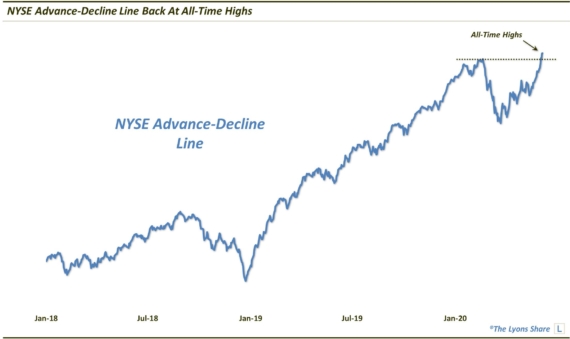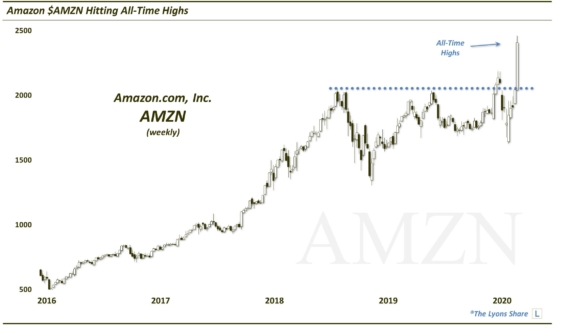Strength In Discretionary Vs. Staples Stocks Is A Positive…If It Were True

The apparent strength in consumer discretionary stocks relative to consumer staples is a function of a few mega-cap names – the action in the broad discretionary sector is actually much worse.
Outside of a few brief spurts, we have spent much of the last 7 months harping on the quality of the rallies in the stock market – or even the quality of the non-rallies. As we have documented extensively, there has been a steady deterioration in the number of stocks exhibiting strength as well as the desirability of the areas that are continuing to hold up. It is generally a good thing for the broader market to see the cyclicals and lower quality names acting well. This suggests that participants, as a whole, are comfortable with the market environment and “risk-on”, so to speak, is at the fore. For the most part, this has not been the case since last spring.
One exception, however, has seemingly been the strength of the consumer discretionary sector, especially relative to consumer staples. When the riskier discretionary stocks do relatively better than the defensive staples, it has generally been a positive for the stock market. Yours truly even noted the positive implications of the action in the discretionary stocks versus staples stocks via a “relative ratio” back in June. That ratio, based on the popular Consumer Discretionary Sector SPDR ETF (XLY) and the Consumer Staples SPDR (XLP) broke out to an all-time high in June, in XLY’s favor. The indication was that discretionary stocks had never been stronger relative to staples.
While the XLY:XLP ratio did not extend itself much further following the breakout, it has been able to maintain the breakout levels ever since, indicating the strength in discretionary stocks had not waned. We took the implications of this development at face value, i.e., as a positive for stocks.
As time wore on, however, we noticed the deterioration in the rest of the cyclical space and thought…hmmm. Why was this sector, which typically deteriorates within a market environment that is weakening internally, actually exhibiting strength? Well, as you have probably noticed, we have spent quite a bit of focus on “equally-weighted” indexes and funds over the past several months. By viewing a market segment based on the equally-weighted performance of all constituents, we get a better grasp of the true strength of the segment. Conversely, when looking at a market cap-weighted segment, its performance may be unduly influenced by its very largest components, positively or negatively.
This is the fly in the ointment in the strong relative performance of discretionary stocks versus staples stocks. Looking at the highest weighted stocks in the XLY, we see a who’s who of the top equity performers this year including Amazon (10% weighting), McDonald’s (4.5%), Starbucks (4%), Nike (4%), etc. Collectively, the top 10 holdings make up 40% of the XLY. At a 10% weighting, Amazon alone takes a lot of the credit for XLY’s performance this year considering its 100%+ performance in 2015.
However, looking below the top 10 surface, we see that things are not quite what they seem in the “robust” discretionary sector. We can do this by looking at the Rydex Equal-Weight Consumer Discretionary ETF (RCD). Again, the RCD weights all of its discretionary components equally so the fund’s performance is a good gauge of the depth of strength in the sector. And based on that, things are not so hot there. Whereas the XLY traded at an all-time high just a few weeks ago, the RCD is well below its highs set in July. And as we have highlighted a few times in these pages, comparatively speaking, the equal-weight:cap-weight ratio (i.e., RCD:XLY) is at a 6-year low.
And compared to the Rydex Equal-Weight Consumer Staples ETF (RHS), the ratio just dropped to a 4-year low. That’s a far cry from the cap-weighted XLY:XLP ratio trading near all-time highs – and perhaps a shock to those hanging their hats on the “out-performing discretionary stocks” thesis

We really don’t like to make excuses or poke holes when an indicator happens to be flashing a particular signal. We prefer to take all signals at face value. However, in this case, there is ample reason, in our view, to be skeptical of the supposed relative out-performance of discretionary stocks vs. consumer staples. The out-performance is essentially concentrated in just the upper echelon of the sector (which, by the way, is probably a solid signal in its own right). However, as judged by the equal-weighted versions, discretionary stocks are badly lagging behind the consumer staples.
Often times, things are not quite what they appear to be in the markets. Such is the case here. What seems like a positive for both the consumer discretionary sector and the risk-taking inclination of market participants in general, actually turns out to be a sector and market negative when taking a broader look. And it is likely enough evidence for us to dismiss the supposed positive message being sent by discretionary stocks.
_____________
More from Dana Lyons, JLFMI and My401kPro.
The commentary included in this blog is provided for informational purposes only. It does not constitute a recommendation to invest in any specific investment product or service. Proper due diligence should be performed before investing in any investment vehicle. There is a risk of loss involved in all investments.


